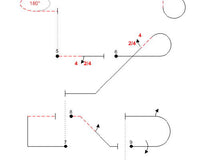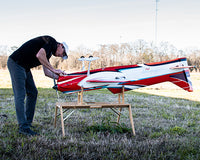This article is written by valued CK Aero contributor Earl Haury
Snap rolls are interesting critters! Reaching consensus on just what they are often seems impossible. On the surface the description in the rules appears straight forward enough, so why the differences in interpretation?
Worth noting, the rules wording describing snaps has changed over time. There are some who seem to be judging by what they remember from the past. It’s important that the current rule wording be the basis for performing and judging snaps.
The AMA rule description probably does a better job of definition than the FAI F3A, but both leave lots of room for individual interpretation. From AMA: “ A snap roll is a rapid rotation where the fuselage nose makes a detectable break in heading from its track in pitch and yaw for the duration of the roll but the track follows the line of the maneuver.” From FAI: “A snap-roll is a rapid auto-rotative roll where the model aircraft is in a stalled attitude, with a continuous high angle of attack.” “At the start of a snap-roll, the fuselage attitude must show a definite stall-break and attitude separation from the flight path, before the rotation is started, since the model aircraft is supposed to be in a stalled condition throughout the snap-roll.” The term “rapid” seems fairly understood, the items of contention generally are “break”, “attitude separation from flight path”, and “stalled”.
Let’s examine these a bit. The “break” requirement is worded differently by AMA and FAI, but both require an attitude separation from the flight path (track). AMA says “detectable” and FAI says “high angle of attack” – wow – no wonder there’s disagreement. Neither really specify how much and the ideal break angle to attain and maintain stall varies with aircraft design. So it could be as little as a couple of degrees (AMA) or lots (FAI). It’s extremely important to understand that this is an attitude only change – the track of the CG must stay the same throughout the maneuver. Note also that AMA says “break in heading from its track in pitch and yaw” whereas FAI says “attitude separation from the flight path, before the rotation is started”. Some interpret the FAI wording to mean pitch only which seems OK, but as described later, won’t really produce a snap.
"No wonder there's disagreement..."
AMA rules also address track deviations (sometimes referred to as offset) “Large deviations from the flight path, indicative of a delayed stall, are to be downgraded using the 1 point per 15-degree rule for each axis of the excursion.” Slow pitch and yaw inputs result in the aircraft departing from the track in pitch and or yaw. Lift occurring during slow control input prior to reaching “stall” is the culprit.
The definition of “stall” likely is the most controversial and creates the most problems in understanding a snap. Simplistically, in lay terms, a wing is considered stalled when it loses lift so as to no longer maintain flight. This definition causes some to express the view that a pattern wing is so lightly loaded that it simply can’t stall, leading to the conclusion that all pattern snaps are phony. Also, it leads some designers to reduce wing area to increase loading so as to improve snaps. Logical enough thinking within the confines of this definition, but inaccurate.
"Stall occurs when a wing or part thereof exceeds its critical angle of attack"
A more correct definition is that a stall occurs when a wing or part thereof exceeds its critical angle of attack (AOA) and air flow separation occurs reducing lift. Note that AOA is the angle of the wing relative to the track of the airplane. An AOA sufficient to provide a snap roll need not be huge and will vary with wing design, the literature suggests only 8-15 degrees is typically enough for a full stall of many full scale wings. (This seems in conflict with the FAI rule stating “high AOA”.) While stall speed will vary with wing loading and CG, a wing of a given design will always stall at the same AOA. Think about this. This is why snaps work at various speeds and not just on horizontal lines but also on vertical lines and from knife edge. The latter two with essentially no wing loading – it’s all about AOA. Note that pitch angles in excess of the critical angle of attack provide deeper stall with significantly more drag. Likewise, pitch angles less than the critical AOA will not produce any level of stall and result in a barrel roll where the CG corkscrews around the track.
Click ahead to 0:51 in the following video to a get a great look at airflow separation as angle of attack increases.
We’ve all some idea of what a snap looks like with most disagreement revolving around the magnitude of the elements. Let’s take a close look at the anatomy of a snap. Why do we need a “break” in pitch? To provide the wing AOA increase so as to reach critical AOA for flow separation. Note that symmetrical flow separation on both wings won’t produce rotation. A near simultaneous yaw input produces asymmetrical flow separation with more on the receding wing and less on the advancing. The resultant lift variation creates the rapid rotation, the airplane reacts as though a wing fell off. Viola – snap roll! It’s critical that we realize this is about delta lift – the difference in lift of the wings – not about depth of stall in total. Depending upon wing design, the pitch and yaw required for quick rotation may be small. Clearly a break is necessary to initiate a snap, but it need not be large for most pattern designs. So, asymmetrical lift resultant from partial flow separation (stall) produces the snap and only needs to be sufficient for rotation, i.e. total flow separation (stall) of the entire wing isn’t needed or wanted.
There’s a reason reducing wing area helps some designs snap. Remember that AOA is relative to track. With a lightly loaded wing the track may change with elevator input which then requires more input to reach critical AOA, if it’s reached at all. At best the track change draws a downgrade, at worst the snap is a barrel roll. This tendency is reduced with a smaller, heavier loaded wing which produces less lift. (Usually at the expense of other parameters.) The real fix is to minimize the time spent changing the pitch angle. Fast elevator servos are mandatory! Not that long ago snaps all seemed to have delayed stalls, significant track offset, and many (most) were barrel rolls. The fast servos we enjoy today pretty much “fixed” snaps by allowing the necessary AOA to be reached almost instantly and therefore not allowing time for track deviation regardless of wing loading.
More pitch angle than necessary provides a deeper stall with more drag resulting in air speed loss, but not faster rotation. The ideal angle is the basis for much of the disagreements as to how much break there must be to satisfy the rules. The pilot who does the work to define the minimum break necessary enjoys clean crisp controllable snaps. Others use way more break than necessary and suffer from difficult to control snaps. Guess what – both are snaps and a few degrees pitch break is just as valid as many degrees, just harder for a judge to see. Correct judging requires both be recognized as proper, even if different than what the judge/pilot prefers.
What do ailerons contribute to snaps? Well, some profess that if the wings are really stalled the ailerons can do nothing. True enough, but remember that the wings are only partially stalled during a snap roll. Actually ailerons do a couple of things. During snap initiation and finish they help overcome roll inertia. Also, aileron input in the direction of the snap modifies each wing panel beneficial to more or less flow separation. Think flaps and spoilers. The removal of this effect at snap finish allows quicker flow attachment as the AOA returns to normal flight attitude. All this makes a snap more controllable.
What about coning of the fuselage during a snap? From AMA: “The track visualized as the path of the Center of Gravity (CG) should closely follow the geometric flight path of the maneuver while the nose and tail rotate through opposite helical arcs around the flight path”. The long tail moment on the pattern plane makes this a tool for a judge to ensure the snap occurs with pitch and yaw attitude separation from the track. However, the closer the break is to minimum the smaller the cone will be for a proper snap. Likewise, the small cone may be indicative of an axial roll with a little deception added. The break is probably more validation of a real snap than coning.
OK, so how do we make textbook snaps happen? Careful snap setup that’s tuned to the airplane with consideration of what judges are looking for. Switching to high rates and stuffing the sticks in the corners won’t get it. Neither will a snap switch. The key is to get the right amount of control input rapidly and at the right time. Just like basic trimming exercises, trimming snaps takes time and work.
The key is to get the right amount of control input rapidly and at the right time
There are various ways of accomplishing the proper snap inputs using sticks and radio functions. The timing differences of inputs are very small but critical for good presentation. (Want to guess why the rules disallow timing functions in the TX?) Take the information in this document and work to find the minimum pitch break needed to get a snap the instant yaw is added. Add a little more pitch to satisfy critical judges. Determine how much yaw is needed for the rotation. When snap rotation is underway, reduce elevator input as much as possible while still retaining the stall provided by the combined pitch and yaw (this helps with the finish). Here again, use a little more pitch and yaw to satisfy the judge critical of coning. Finally work on aileron travels to get a clean start and stop of the snap. Don’t overlook the possibility that significant differential may reinforce the yaw and/or flow separation during the snap. The control sequence should be very fast pitch input, quickly followed by yaw, followed by roll (aileron), reduction of pitch, then neutral to finish. Some designs may finish better with a slight input of opposite elevator and/or rudder so as to quickly return the wing below critical AOA. Generally, an airplane trimmed (via Triangulation Trimming techniques) for pattern will have sufficient stability to finish snaps without any control reversal.
The control sequence should be very fast pitch input, quickly followed by yaw, followed by roll (aileron), reduction of pitch, then neutral to finish.
Whew — Lots of words to describe something that occurs in a fraction of a second! The good news is that snaps with pattern airplanes are real. The aerodynamics are reasonably clear and repeatable. Consistent execution requires proper trimming and inputs. Like everything else in pattern, practice, practice…











